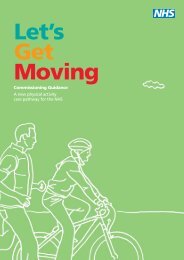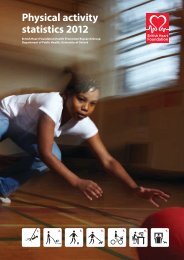Sedentary behaviour evidence briefing - BHF National Centre ...
Sedentary behaviour evidence briefing - BHF National Centre ...
Sedentary behaviour evidence briefing - BHF National Centre ...
Create successful ePaper yourself
Turn your PDF publications into a flip-book with our unique Google optimized e-Paper software.
1<br />
<strong>Sedentary</strong> <strong>behaviour</strong><br />
Evidence Briefing<br />
<strong>Sedentary</strong> <strong>behaviour</strong><br />
Costs of<br />
Physical Inactivity<br />
Funded by
Contents<br />
Summary 1<br />
Introduction 1<br />
What is sedentary <strong>behaviour</strong>? 2<br />
Physical and psychological health outcomes 3<br />
of sedentary <strong>behaviour</strong><br />
Current levels of sedentary <strong>behaviour</strong> 5<br />
Factors influencing sedentary <strong>behaviour</strong> 7<br />
Public health guidelines 8<br />
Interventions to reduce sedentary <strong>behaviour</strong> 8<br />
Implications for practice 9<br />
The purpose of this <strong>evidence</strong> <strong>briefing</strong> is to provide an overview of the <strong>evidence</strong> relating to sedentary <strong>behaviour</strong> and<br />
public health to help commissioners, policy makers and practitioners influence work in this field. It defines sedentary<br />
<strong>behaviour</strong> and summarises the risks, current levels and the factors influencing this <strong>behaviour</strong> as well as the current<br />
<strong>evidence</strong> for effectiveness of interventions to reduce sedentary <strong>behaviour</strong>. The new UK Chief Medical Officers’ physical<br />
activity guidelines for sedentary <strong>behaviour</strong> and the implications for policy and practice are highlighted.
Summary<br />
The <strong>evidence</strong> reviewed in this document indicates:<br />
• <strong>Sedentary</strong> <strong>behaviour</strong> (<strong>behaviour</strong> such as sitting and<br />
lying) is not defined simply as a lack of physical<br />
activity (‘inactivity’) but is a separate <strong>behaviour</strong> in<br />
its own right.<br />
• <strong>Sedentary</strong> <strong>behaviour</strong>s can occur in all age groups<br />
at work and school, during leisure-time and whilst<br />
using motorised transport.<br />
• <strong>Sedentary</strong> <strong>behaviour</strong> may be adversely associated<br />
with chronic disease in adults and risk factors for<br />
chronic disease in children and adolescents.<br />
• Even individuals who currently meet recommended<br />
levels of physical activity may be susceptible to the<br />
adverse effects of prolonged bouts of sedentary<br />
<strong>behaviour</strong>.<br />
• Patterns of sedentary <strong>behaviour</strong> established during<br />
childhood persist at a moderate level throughout<br />
childhood and adolescence.<br />
• Levels of sedentary <strong>behaviour</strong> typically increase<br />
with age.<br />
• Family- and home-related factors are an important<br />
influence on sedentary <strong>behaviour</strong> during childhood.<br />
• Public health guidelines recommend that people of<br />
all ages should avoid prolonged periods of sedentary<br />
<strong>behaviour</strong>.<br />
• Interventions to reduce sedentary <strong>behaviour</strong> in<br />
children have generally been successful. However,<br />
the effects are small and the characteristics of<br />
successful interventions are unclear.<br />
• More research is needed to identify effective<br />
methods of reducing sedentary <strong>behaviour</strong> in adults.<br />
Introduction<br />
For the majority of our evolutionary history humans<br />
lived a hunter gatherer existence which required<br />
high levels of physical activity to acquire food and<br />
water, obtain shelter and avoid predators. Over time,<br />
advances in technology and agriculture gradually<br />
reduced the energy expenditure required to fulfil<br />
these survival needs (1, 2) . Today, in many developed<br />
countries, large segments of the population now spend<br />
a significant proportion of their day sitting and using<br />
labour-saving devices.<br />
The benefits of a physically active lifestyle for<br />
morbidity and mortality are well established and<br />
reflected in public health guidelines and policy (3) .<br />
In recent years, however, there has been growing<br />
interest in the role that sedentary <strong>behaviour</strong> may<br />
play in health and wellbeing. Informed by this<br />
emerging body of <strong>evidence</strong>, public health guidelines<br />
now recommend that people of all ages should avoid<br />
prolonged periods of sedentary <strong>behaviour</strong> and break<br />
up periods of sitting (3) .<br />
Making physical activity a priority
2<br />
<strong>Sedentary</strong> <strong>behaviour</strong><br />
What is sedentary <strong>behaviour</strong>?<br />
<strong>Sedentary</strong> <strong>behaviour</strong> refers to a group of <strong>behaviour</strong>s<br />
that occur whilst sitting or lying down while awake<br />
and typically require very low energy expenditure (4) .<br />
The low energy requirements distinguish sedentary<br />
<strong>behaviour</strong>s from other <strong>behaviour</strong>s that also occur<br />
whilst seated but require greater effort and energy<br />
expenditure, eg, using a rowing machine. The position<br />
of sedentary <strong>behaviour</strong> on the energy expenditure<br />
continuum, and in relation to sleep and physical<br />
activity, is presented in Figure 1 (adapted from (5) ).<br />
Figure 1. Human movement and energy<br />
expenditure continuum.<br />
Examples of sedentary <strong>behaviour</strong><br />
In many industrialised societies, occupational sitting<br />
represents the major source of sedentary <strong>behaviour</strong> in<br />
adults. Children may accumulate substantial sedentary<br />
time whilst at school, eg, during lessons. During<br />
leisure-time, common sedentary <strong>behaviour</strong>s include<br />
watching television, using a computer or playing video<br />
games (excluding ‘active’ gaming), reading and sitting<br />
whilst socialising with friends or family. <strong>Sedentary</strong><br />
time may also be accumulated whilst using motorised<br />
transport, particularly door-to-door transport in a car.<br />
For the purpose of this <strong>evidence</strong> <strong>briefing</strong>, the<br />
population is divided into two groups: children and<br />
young people (which includes early years, ie, children<br />
under the age of 5 and children and young people aged<br />
5 to 16) and adults (which includes adults aged 17 to<br />
64 and older adults, aged 65+).<br />
<strong>Sedentary</strong> <strong>behaviour</strong> is not defined simply as a lack<br />
of physical activity but is a separate <strong>behaviour</strong><br />
in its own right. It is possible for individuals to<br />
participate in the recommended amount of physical<br />
activity and also engage in high levels of sedentary<br />
<strong>behaviour</strong>. Moreover, the health outcomes of sedentary<br />
<strong>behaviour</strong> have often been identified independent<br />
of participation in physical activity. It would be<br />
inaccurate to surmise that an individual is ‘sedentary’<br />
based solely upon data indicating that they are not<br />
sufficiently active or that an individual who does not<br />
meet the guideline amount of physical activity spends<br />
their entire time sitting (3) .
Evidence Briefing<br />
3<br />
Physical and psychological<br />
health outcomes of sedentary<br />
<strong>behaviour</strong><br />
Since the late 1990s there has been rapid growth<br />
in research exploring the association of sedentary<br />
<strong>behaviour</strong> with various health outcomes. Here we<br />
summarise the <strong>evidence</strong> linking sedentary <strong>behaviour</strong><br />
with physical and psychological wellbeing in adults and<br />
children and young people (5-8) .<br />
Adults<br />
Recent reviews of the literature, focusing on<br />
prospective studies, have found consistent <strong>evidence</strong><br />
that sedentary <strong>behaviour</strong>:<br />
• is associated with an increased risk of type 2<br />
diabetes, cardiovascular disease and death from all<br />
(6, 7, 9)<br />
causes<br />
• may increase risk of certain types of cancer, but<br />
findings are somewhat inconsistent (6, 9, 10) .<br />
Despite being widely studied, the association of<br />
sedentary <strong>behaviour</strong> with overweight/obesity<br />
or weight gain remains plausible yet unproven.<br />
Accordingly, more research is required to either<br />
support or refute an association between sedentary<br />
<strong>behaviour</strong> and weight status as well as cancer.<br />
A small number of studies have reported that<br />
sedentary <strong>behaviour</strong> may be adversely associated<br />
with psychological health, eg, depression and mental<br />
wellbeing, but more research is needed (11, 12) .<br />
Key term – prospective/longitudinal study<br />
Prospective studies, also known as cohort or<br />
longitudinal studies, examine the development of<br />
disease (or other health outcome) by measuring a<br />
risk factor at the beginning of the study (baseline)<br />
and then following participants over time to assess<br />
who does and does not develop disease. These<br />
studies provide stronger <strong>evidence</strong> that a risk factor<br />
may be causally associated with disease compared<br />
to cross-sectional (‘snapshot’) studies which<br />
measure both risk factor and disease status at the<br />
same point in time.<br />
Children and young people<br />
The association of TV viewing and computer use with<br />
weight status in children and young people has been<br />
studied extensively. Previous reviews of the literature<br />
have reported that TV and computer use are adversely<br />
associated with weight status, but the association<br />
is small (13) . A more recent review summarising only<br />
prospective studies reported mixed <strong>evidence</strong> linking<br />
TV and computer use with weight status (8) . In contrast,<br />
a second review found positive associations between<br />
screen time and the consumption of energy dense<br />
food (14) . The <strong>evidence</strong> on this issue, therefore,<br />
remains uncertain and is subject to on-going debate.<br />
High quality research exploring the association<br />
of sedentary <strong>behaviour</strong> with other physical and<br />
psychological health outcomes in children and young<br />
people is lacking. There however, is some <strong>evidence</strong><br />
that sedentary <strong>behaviour</strong> is associated with lower<br />
levels of aerobic fitness (8) and adverse cardiovascular<br />
disease risk factor profiles (15) .<br />
Evidence to inform recommendations for<br />
sedentary <strong>behaviour</strong><br />
The health outcomes associated with sedentary<br />
<strong>behaviour</strong> in children, young people and adults<br />
remains a relatively new field of study, with a much<br />
smaller <strong>evidence</strong> base than that accumulated for<br />
physical activity and health outcomes. Most studies<br />
to date have focused solely upon the health outcomes<br />
associated with TV viewing while the health outcomes<br />
of other forms of sedentary <strong>behaviour</strong>, for example,<br />
occupational sitting or ‘total’ sedentary time, are<br />
less clear. For these reasons, it is currently not<br />
possible to provide an <strong>evidence</strong>-based quantitative<br />
recommendation, eg,
4<br />
<strong>Sedentary</strong> <strong>behaviour</strong><br />
• Existing literature indicates sedentary <strong>behaviour</strong><br />
patterns appear to be relatively stable over time<br />
during childhood and adolescence, indicating<br />
programmes aimed at reducing sedentary <strong>behaviour</strong><br />
should begin during childhood.<br />
• Many of the potential health outcomes associated<br />
with sedentary <strong>behaviour</strong>, in both children and<br />
adults, have been found to be independent of<br />
physical activity. That is, even individuals who<br />
currently meet recommended levels of physical<br />
activity may be susceptible to the adverse effects of<br />
prolonged bouts of sedentary <strong>behaviour</strong>.<br />
patterns of sedentary <strong>behaviour</strong> established during<br />
childhood are relatively stable over time. These<br />
findings suggest efforts to reduce sedentary <strong>behaviour</strong><br />
should begin during childhood and adolescence (16) .<br />
Key term – experimental study<br />
Experimental studies seek to determine the<br />
cause and effect relationship between a specific<br />
intervention and a predetermined outcome. In this<br />
approach, the researcher identifies two sets of<br />
variables; one set is manipulated while the other<br />
is used for measuring the changes or outcomes.<br />
Experimental studies have a pre-post-test design,<br />
a treatment and control group and random<br />
assignment of study participants.<br />
Key term – track/tracking<br />
The degree to which sedentary <strong>behaviour</strong> patterns<br />
persist over time is known as tracking. High levels<br />
of tracking indicate patterns are stable over time.<br />
An example of ‘good’ or ‘high’ levels of tracking<br />
would be a child who engages in high quantities of<br />
sedentary <strong>behaviour</strong> at age 10 and continues to do<br />
so at age 15 and beyond.<br />
Summary<br />
• There is a growing body of <strong>evidence</strong> linking<br />
sedentary <strong>behaviour</strong> with chronic disease morbidity<br />
and mortality in adults and preliminary <strong>evidence</strong> to<br />
suggest sedentary <strong>behaviour</strong> may also be a health<br />
risk in children and young people.<br />
• The <strong>evidence</strong> is currently limited by a predominant<br />
focus on TV viewing or screen time and lacks high<br />
quality prospective and experimental research.
Evidence Briefing<br />
5<br />
Current levels of sedentary<br />
<strong>behaviour</strong><br />
In this section we summarise findings from the available<br />
surveillance studies in the four home countries<br />
(England, Scotland, Wales and Northern Ireland), where<br />
available, describing levels of sedentary <strong>behaviour</strong><br />
in adults and children. As noted previously, much of<br />
existing research has focused solely upon TV viewing or<br />
other screen-based <strong>behaviour</strong>s. More data are required<br />
in both children and adults to establish total daily<br />
sedentary <strong>behaviour</strong> and time spent in other domains<br />
of sedentary <strong>behaviour</strong>, eg, occupational/school and<br />
transport-related sitting time.<br />
Adults<br />
England<br />
• Total daily sedentary time increased with age<br />
(Figure 2).<br />
• Adults on average watched 2.8 hours of TV on<br />
weekdays and 3.2 (men) and 3.0 (women) hours per<br />
day at the weekend.<br />
• Daily TV viewing time increased with age in both<br />
men and women from approximately 2.5 hours per<br />
day for those aged 16-24 up to almost 4 hours per<br />
day in those aged 75+ years (17) .<br />
Scotland<br />
• The average time adults spent on TV viewing and<br />
other screen-based entertainment was 3.6 (men)<br />
and 3.2 (women) hours per day (Figure 3) (18) .<br />
Northern Ireland and Wales<br />
• No data is currently available for Northern Ireland<br />
and Wales.<br />
Children and young people<br />
England<br />
• Total daily sedentary time, assessed by accelerometer,<br />
increased with age from 6-7 hours per day at age 4-7<br />
years to 8-9 hours per day at age 12-15.<br />
• In general, daily TV viewing increased with age<br />
(Figure 4) (17) .<br />
• 41% of boys and 13% of girls reported more than<br />
2 hours of game playing (on a computer or games<br />
console) per day (19) .<br />
Figure 2. Total sedentary time in English adults,<br />
assessed by accelerometer<br />
Data Source: Health Survey for England 2008<br />
Figure 3. Daily TV and other screen-viewing<br />
in Scottish adults<br />
Data Source: The Scottish Health Survey 2003<br />
Figure 4. TV viewing in English children<br />
aged 2-15 years<br />
Data Source: Health Survey for England 2008<br />
Making physical activity a priority
6<br />
<strong>Sedentary</strong> <strong>behaviour</strong><br />
Scotland<br />
• 50% of boys and 19% of girls reported more than<br />
2 hours of game playing (on a computer or games<br />
console) per day (19) .<br />
• Among children aged approximately 4 years,<br />
33% watched less than 60 minutes of TV per day<br />
and 30% exceeded 2 hours per day (20) .<br />
• On weekdays, 62% of boys and 57% of girls aged<br />
11 years exceeded 2 hours per day of TV viewing.<br />
These figures increased to 69% (boys) and 68% (girls)<br />
at age 15 years (21) .<br />
• Additionally, 53% of boys and 29% of girls aged 11<br />
years reported greater than 2 hours of computer<br />
game play (weekdays). At age 15 these figures<br />
increased to 64% in boys but decreased to 26% in<br />
girls (21) .<br />
Wales<br />
• In 2005/2006, 43% of boys and 19% of girls reported<br />
more than 2 hours of game playing (on a computer<br />
or games console) per day (19) .<br />
• Overall, 67% of girls and 70% of boys aged 11-16<br />
years reported greater than 2 hours per day of TV<br />
viewing on weekdays (22) .<br />
• 61% of girls and 51% of boys aged 11–16 reported 2<br />
hours or more of computer use (playing games and<br />
internet use) on weekdays (22) .<br />
• The proportion of respondents exceeding 2 hours<br />
per day of TV viewing and computer use increased<br />
with age (Figure 5) (22) .<br />
Northern Ireland<br />
The largest proportion of young people in Northern<br />
Ireland, age 11-16 years, reported using the TV or<br />
computer/console games for less than 10 hours per<br />
week (Figure 6) (23) .<br />
Figure 5. Proportion of Welsh children exceeding two<br />
hours/day of TV viewing and computer use<br />
Data Source: Health Behaviour in School Aged Children 2009/2010<br />
Figure 6. Hours of use per week in young people<br />
in Northern Ireland<br />
Hours per week<br />
Data Source: Northern Ireland’s Young Persons’<br />
Behaviour & Attitudes Survey 2010
Evidence Briefing<br />
7<br />
Factors influencing sedentary<br />
<strong>behaviour</strong><br />
A key step in the development of programmes aimed<br />
at reducing sedentary <strong>behaviour</strong> is to identify factors<br />
(correlates) associated with participation in sedentary<br />
<strong>behaviour</strong> (24) . Research into the correlates of<br />
sedentary <strong>behaviour</strong> is emerging, but the majority of<br />
studies to date have focused solely upon TV viewing or<br />
other screen-based <strong>behaviour</strong>s. Below, we summarise<br />
the <strong>evidence</strong> for sedentary <strong>behaviour</strong> correlates in<br />
adults and children and young people.<br />
Key term – correlates<br />
Correlates are factors that influence <strong>behaviour</strong>.<br />
Correlates may be fixed or non-modifiable, eg,<br />
sex, ethnicity, age, which are useful for identifying<br />
population groups that should be targeted in<br />
intervention programmes. Alternatively, correlates<br />
may be modifiable, for example, social support,<br />
attitudes, or parental rules, wherein intervention<br />
strategies may be developed to change these<br />
factors potentially leading to changes in <strong>behaviour</strong>.<br />
Adults<br />
There is currently a lack of research exploring the<br />
correlates of sedentary <strong>behaviour</strong> in adults. While<br />
more research is needed to identify modifiable<br />
correlates of sedentary <strong>behaviour</strong> in adults, the<br />
<strong>evidence</strong> we have related to sedentary <strong>behaviour</strong> is:<br />
Biological factors<br />
• Age: In general, sedentary <strong>behaviour</strong> increases<br />
with age, with <strong>evidence</strong> of a marked increase from<br />
approximately 60 years of age onwards (25) .<br />
• Gender: Whether men or women are more<br />
sedentary appears to differ according to the<br />
particular age range under study. Up to the age<br />
of 40 years, women appear to engage in higher<br />
levels of sedentary <strong>behaviour</strong>, whilst in those aged<br />
60 years and above levels of sedentary <strong>behaviour</strong><br />
appear to be greater among men (25) .<br />
Demographic factors<br />
• Socio-economic status (SES): Consistent with<br />
findings from other countries, data from the<br />
Scottish Health Survey indicate screen-based<br />
sedentary <strong>behaviour</strong> is greatest in low (SES)<br />
groups (18) .<br />
There is currently no <strong>evidence</strong> on social, cultural and<br />
environmental factors and associations with sedentary<br />
<strong>behaviour</strong> in adults.<br />
Children and young people<br />
This summary is based upon recent reviews of the<br />
literature (26-32) :<br />
Biological factors<br />
• Age: <strong>Sedentary</strong> <strong>behaviour</strong> increases during<br />
childhood and from childhood into adolescence.<br />
• Gender: In young children (less than ten years),<br />
TV viewing and computer use do not appear to<br />
differ between boys and girls. During adolescence,<br />
there is some <strong>evidence</strong> to suggest boys typically<br />
spend more time than girls watching TV or using a<br />
computer (especially playing computer games).<br />
Demographic factors<br />
• Socio-economic status: Markers of SES, such<br />
as parental income or education, are inversely<br />
associated with sedentary <strong>behaviour</strong> (ie, sedentary<br />
<strong>behaviour</strong> tends to be higher in low SES groups).<br />
• Ethnicity: Levels of TV viewing are typically higher<br />
in ‘non-white’ ethnic groups, eg, African-American.<br />
Social/cultural factors<br />
• Parental <strong>behaviour</strong>s and practices: Young people<br />
tend to have higher levels of sedentary <strong>behaviour</strong> if<br />
their parents or siblings also engage in high levels of<br />
sedentary <strong>behaviour</strong>.<br />
• Accessibility: Having more television sets or<br />
computers within the home and having a TV in the<br />
bedroom is also associated with higher usage.<br />
• Rules: Parental rules regarding TV and computer use<br />
are associated with lower levels of participation in<br />
these <strong>behaviour</strong>s for young people.<br />
There is currently no <strong>evidence</strong> on environmental<br />
factors and associations with sedentary <strong>behaviour</strong> in<br />
children and young people.<br />
Making physical activity a priority
8<br />
<strong>Sedentary</strong> <strong>behaviour</strong><br />
Public health guidelines<br />
Public health guidelines for sedentary <strong>behaviour</strong> are a<br />
relatively new development. In July 2011 the UK joined<br />
Australia and Canada (among others) in providing public<br />
health guidelines aimed specifically at highlighting<br />
the potential health risks associated with sedentary<br />
<strong>behaviour</strong> and encouraging people of all ages to limit<br />
their participation in these <strong>behaviour</strong>s (3) .<br />
For each age group addressed in the current public<br />
health guidelines (early years, children and young<br />
people, adults and older adults), it is recommended<br />
they: “should minimise the amount of time spent<br />
being sedentary (sitting) for extended periods”.<br />
This guideline reflects the growing body of <strong>evidence</strong><br />
indicating sedentary <strong>behaviour</strong> may be adversely<br />
associated with various physical and psychological<br />
health outcomes. However, this remains a relatively<br />
new field of research, and unlike guidelines provided<br />
for physical activity, it is not yet possible to provide a<br />
quantitative recommendation to indicate a duration<br />
of sedentary time above which health may be at<br />
risk, eg, two hours/day. As the <strong>evidence</strong> continues<br />
to accumulate, it may become possible to refine this<br />
guideline and provide more precise recommendations.<br />
The current public health guideline is intentionally<br />
global in its scope, recommending that people of<br />
all ages limit their sedentary time without specific<br />
reference to a particular type of sedentary <strong>behaviour</strong>,<br />
eg, TV viewing, or context, eg, leisure-time, school or<br />
occupation. This is because it is not currently known<br />
whether different types of sedentary <strong>behaviour</strong>, or the<br />
different contexts in which the <strong>behaviour</strong> takes place,<br />
may be differentially associated with health. Much of<br />
the existing <strong>evidence</strong> is based upon TV viewing and<br />
computer use accumulated during leisure-time, but<br />
research exploring other <strong>behaviour</strong>s in other contexts<br />
is emerging and will help to refine future public health<br />
recommendations. Based upon the current guideline<br />
it is recommended efforts are directed towards a<br />
general reduction in sedentary <strong>behaviour</strong> and breaking<br />
up periods of prolonged sitting.
Evidence Briefing<br />
9<br />
Interventions to reduce<br />
sedentary <strong>behaviour</strong><br />
The growth in <strong>evidence</strong> linking sedentary <strong>behaviour</strong><br />
with physical and psychological health outcomes has<br />
led to an increasing number of interventions aimed<br />
at reducing sedentary <strong>behaviour</strong> in both adults (33)<br />
and children and young people (34, 35) .<br />
Adults<br />
Relatively few intervention studies have been<br />
conducted to reduce sedentary <strong>behaviour</strong> in adults.<br />
A recent review examined the effectiveness of<br />
workplace interventions to reduce sitting time (33) .<br />
Only six studies were identified for the review, and<br />
none were found to be effective in reducing sitting<br />
time. One possible explanation for this lack of<br />
effectiveness is all reviewed studies were principally<br />
concerned with increasing physical activity; reducing<br />
sedentary <strong>behaviour</strong> was included only as a secondary<br />
outcome. The correlates of sedentary <strong>behaviour</strong> are<br />
likely to be different from those of physical activity,<br />
and as such, it is unsurprising that no changes in<br />
sedentary <strong>behaviour</strong> were observed. In addition,<br />
all studies used self-report methods for measuring<br />
sedentary <strong>behaviour</strong> which may not be sufficiently<br />
sensitive to detect changes in this <strong>behaviour</strong>.<br />
Children and young people<br />
Recent reviews have examined the effectiveness of<br />
interventions aimed at reducing sedentary <strong>behaviour</strong><br />
in children and young people (34, 35) . Studies included<br />
in these reviews focused exclusively upon reducing<br />
screen-based sedentary <strong>behaviour</strong>s, eg, TV viewing,<br />
computer use, and the majority were conducted<br />
outside the UK. Interventions to reduce sitting in<br />
young people have generally been effective, but<br />
changes in <strong>behaviour</strong> have been relatively small. There<br />
is limited information on what characterises effective<br />
interventions in terms of intervention content and<br />
key target groups. There is some <strong>evidence</strong> that<br />
interventions including family/parental involvement<br />
are likely to produce greater changes in sedentary<br />
<strong>behaviour</strong>. This is consistent with correlates research<br />
indicating the family and home level factors are a key<br />
influence on sedentary <strong>behaviour</strong>s in young people.<br />
Reducing sedentary <strong>behaviour</strong> – how is time<br />
re-allocated?<br />
A key consideration in evaluating interventions to<br />
reduce sedentary <strong>behaviour</strong> is how time is re-allocated<br />
if a change in the targeted <strong>behaviour</strong> is achieved. For<br />
example, if an intervention successfully produces a 20<br />
minute reduction in TV viewing it is important to know<br />
how that time is re-allocated. If time is simply shifted<br />
from one form of sedentary <strong>behaviour</strong> to another, as<br />
has been shown in some studies (36) , there may be no<br />
net benefit for health. For this reason, evaluation of<br />
sedentary <strong>behaviour</strong> interventions should use methods<br />
that assess total sedentary time and time spent in a<br />
wide range of sedentary <strong>behaviour</strong>s.<br />
Summary<br />
• The <strong>evidence</strong> base on effective methods for<br />
reducing sedentary <strong>behaviour</strong> is currently very<br />
small, and there is little information on which to<br />
base recommendations for particular intervention<br />
methods or strategies.<br />
• Drawing upon both the correlates and intervention<br />
literature, it appears interventions targeting<br />
the whole family, including parents and siblings,<br />
may be an effective method of reducing screenbased<br />
sedentary <strong>behaviour</strong>s in children and early<br />
adolescents.<br />
• The development and evaluation of interventions<br />
aimed at reducing sedentary <strong>behaviour</strong> in children<br />
and adults is a priority.<br />
• In children and young people, there is a need for<br />
studies that target <strong>behaviour</strong>s other than screenbased<br />
media and in domains other than leisuretime,<br />
such as school or transport.<br />
• In adults, interventions targeting transport and<br />
leisure-time sedentary <strong>behaviour</strong> are required,<br />
as well as prolonged sitting in the workplace.<br />
• In studies with adults and children and young<br />
people, objective methods of measuring sedentary<br />
time should be used wherever possible.<br />
Making physical activity a priority
10<br />
<strong>Sedentary</strong> <strong>behaviour</strong><br />
Implications for practice<br />
The <strong>evidence</strong> summarised in this document has<br />
important implications for commissioners, policymakers<br />
and practitioners. Potential action areas for<br />
each of these groups are outlined below. Strategies to<br />
reduce sedentary <strong>behaviour</strong> should be implemented<br />
alongside those aimed at increasing participation in<br />
physical activity.<br />
Actions for commissioners<br />
• Consider commissioning interventions which focus<br />
on reducing sedentary <strong>behaviour</strong>.<br />
• Commission programmes aimed at reducing<br />
sedentary <strong>behaviour</strong> in adults for whom there is<br />
consistent <strong>evidence</strong> that sedentary <strong>behaviour</strong> is<br />
associated with increased risk of certain diseases<br />
and conditions. Give particular consideration to<br />
settings (eg, workplace) and age groups (eg, older<br />
adults) where there is greatest potential to reach<br />
high numbers of people who are sedentary for<br />
extended periods of time.<br />
• Consider commissioning family and home-level<br />
interventions as they appear to be effective in<br />
reducing screen-based sedentary <strong>behaviour</strong>s in<br />
children and young people.<br />
• Ensure that robust monitoring and evaluation is<br />
built into local programmes to help develop the<br />
<strong>evidence</strong> base on effective interventions to reduce<br />
sedentary <strong>behaviour</strong>.
Evidence Briefing<br />
11<br />
Actions for policy makers<br />
• Policy-makers from various disciplines, including<br />
health, education, welfare, occupational health<br />
and social development, should be aware of the<br />
importance of reducing sedentary <strong>behaviour</strong>s.<br />
• Action should be taken to reduce the potential<br />
health risks associated with sedentary <strong>behaviour</strong><br />
through policy measures.<br />
• <strong>Sedentary</strong> <strong>behaviour</strong> reduction should be a standard<br />
policy item in guidance documents on health.<br />
• Assess in advance what impact (both intended and<br />
unintended) any policy proposals are likely to have<br />
on sedentary <strong>behaviour</strong>.<br />
• Provide educational opportunities on sedentary<br />
<strong>behaviour</strong> for different professional groups who can<br />
help reduce this <strong>behaviour</strong>.<br />
• Policy makers should support and encourage<br />
employers to take steps to minimise sedentary<br />
<strong>behaviour</strong>s in employees, including regular breaks<br />
from sitting at a computer.<br />
• Policy makers should support and encourage schools<br />
to consider how they can reduce extended periods<br />
of sitting for pupils.<br />
Actions for practitioners<br />
• Practitioners working in various disciplines,<br />
including primary care, welfare, education and<br />
occupational health, should review their knowledge<br />
and understanding of the health risks associated<br />
with sedentary <strong>behaviour</strong>.<br />
• Action should be taken to minimise risk in the<br />
practitioner’s target audience.<br />
• All age groups (children, younger people, adults and<br />
older adults) should be educated on the potential<br />
health risks of sedentary <strong>behaviour</strong> and be provided<br />
with strategies they can adopt to break up their<br />
sedentary time.<br />
• Regular active breaks should be encouraged during<br />
work and school time.<br />
• During leisure-time, active breaks should focus<br />
upon times of day when sedentary <strong>behaviour</strong>s are<br />
most likely to occur, such as after school or work,<br />
evenings, weekends and during holidays.<br />
• Practitioners should promote and help develop<br />
strategies which encourage families to set rules or<br />
‘quotas’ on screen-time and remove TVs or video<br />
game machines from bedrooms.<br />
• Practitioners working with parents/carers should<br />
encourage them to limit the amount of time young<br />
children are restrained in highchairs, pushchairs or<br />
car seats.<br />
• Practitioners should encourage parents to be<br />
good role models by reducing personal sedentary<br />
<strong>behaviour</strong>.<br />
• Practitioners should implement robust monitoring<br />
and evaluation of local programmes.<br />
Making physical activity a priority
12<br />
<strong>Sedentary</strong> <strong>behaviour</strong><br />
References<br />
1. Brown WJ, Bauman AE, Owen N. Stand up, sit down,<br />
keep moving: Turning circles in physical activity<br />
research? Br J Sports Med. 2009 02;43(1473-0480; 0306-<br />
3674; 2):86-8.<br />
2. Katzmarzyk PT, Mason C. The physical activity<br />
transition. J Phys Act Health. 2009 05;6(1543-3080;<br />
1543-3080; 3):269-80.<br />
3. The Department of Health. Start active, stay active:<br />
a report on physical activity for health from the four<br />
home countries’ Chief Medical Officers. 2011.<br />
4. Pate RR, O’Neill JR, Lobelo F. The Evolving Definition of<br />
“<strong>Sedentary</strong>”. Exerc Sport Sci Rev. 2008 10;36(4):173-8.<br />
5. Tremblay MS, Colley RC, Saunders TJ, Healy GN, Owen<br />
N. Physiological and health implications of a sedentary<br />
lifestyle. Appl Physiol Nutr Metab. 2010 12;35(1715-<br />
5312; 6):725-40.<br />
6. Proper KI, Singh AS, van Mechelen W, Chinapaw MJ.<br />
<strong>Sedentary</strong> behaviors and health outcomes among adults:<br />
a systematic review of prospective studies. Am J Prev<br />
Med. 2011;40(2):174-82.<br />
7. Grontved A, Hu FB. Television Viewing and Risk of<br />
Type 2 Diabetes, Cardiovascular Disease, and All-Cause<br />
Mortality: A Meta-analysis. JAMA. 2011 06/15;305(1538-<br />
3598; 0098-7484; 23):2448-55.<br />
8. Chinapaw MJ, Proper KI, Brug J, Van MW, Singh AS.<br />
Relationship between young peoples’ sedentary<br />
<strong>behaviour</strong> and biomedical health indicators: a<br />
systematic review of prospective studies. Obes Rev.<br />
2011 07;12(1467-789; 1467-7881; 7):e621-32.<br />
9. Thorp AA, Owen N, Neuhaus M, Dunstan DW. <strong>Sedentary</strong><br />
behaviors and subsequent health outcomes in adults a<br />
systematic review of longitudinal studies, 1996-2011.<br />
Am J Prev Med. 2011 08;41(1873-2607; 0749-3797;<br />
2):207-15.<br />
10. Boyle T, Fritschi L, Heyworth J, Bull F. Longterm<br />
sedentary work and the risk of subsite-specific<br />
colorectal cancer. Am J Epidemiol. 2011<br />
05/15;173(1476-6256; 0002-9262; 10):1183-91.<br />
11. Hamer M, Stamatakis E, Mishra GD. Television- and<br />
Screen-Based Activity and Mental Well-Being in Adults.<br />
Am J Prev Med. 2010 04;38(4):375-80.<br />
12. Teychenne M, Ball K, Salmon J. <strong>Sedentary</strong> behavior and<br />
depression among adults: a review. Int J Behav Med.<br />
2010 12;17(1532-7558; 1070-5503; 4):246-54.<br />
13. Marshall SJ, Biddle SJ, Gorely T, Cameron N, Murdey<br />
I. Relationships between media use, body fatness and<br />
physical activity in children and youth: a meta-analysis.<br />
Int J Obes Relat Metab Disord. 2004 10;28(0307-0565;<br />
0307-0565; 10):1238-46.<br />
14. Pearson N, Biddle SJH. <strong>Sedentary</strong> behavior and dietary<br />
intake in children, adolescents, and adults. A systematic<br />
review. Am J Prev Med. 2011;41(2):178-88.<br />
15. Tremblay MS, LeBlanc AG, Kho ME, Saunders TJ,<br />
Larouche R, Colley RC, et al. Systematic review of<br />
sedentary <strong>behaviour</strong> and health indicators in schoolaged<br />
children and youth. Int J Behav Nutr Phys Act.<br />
2011;8(98).<br />
16. Biddle SJH, Pearson N, Ross GM, Braithwaite R. Tracking<br />
of sedentary <strong>behaviour</strong>s of young people: a systematic<br />
review. Prev Med. 2010;51:345-51.<br />
17. Health Survey for England 2008. Volume 1: Physical<br />
activity and fitness. Leeds: The NHS Information <strong>Centre</strong><br />
for health and social care; 2009.<br />
18. Stamatakis E, Hillsdon M, Mishra G, Hamer M,<br />
Marmot M. Television viewing and other screen-based<br />
entertainment in relation to multiple socioeconomic<br />
status indicators and area deprivation: The Scottish<br />
Health Survey 2003. J Epidemiol Community Health.<br />
2009 09;63(1470-2738; 0143-005; 9):734-40.<br />
19. World Health Organization. Young people’s health in<br />
Great Britain and Ireland. Findings from the Health<br />
Behaviour in School-Aged Children Survey 2006. 2009.<br />
20. Growing up in Scotland: Year 2. Results from the<br />
second year of a study following the lives of Scotland’s<br />
children. Edinburgh: The Scottish Government; 2008.<br />
21. HBSC Scotland <strong>National</strong> Report. Health <strong>behaviour</strong><br />
in school aged children: World Health Organization<br />
collaborative cross-national study (HBSC). Findings from<br />
the 2010 HBSC Survey in Scotland. 2011.<br />
22. Health Behaviour in School-Aged Children: Initial<br />
findings from the 2009/10 survey in Wales. Ipsos MORI<br />
Social Research Institute; 2011.
Evidence Briefing<br />
13<br />
23. Northern Ireland Statistics & Research agency. Young<br />
Persons’ Behaviour & Attitudes Survey 2010: Top-Line<br />
Results. Belfast: Central Survey Unit; 2011.<br />
24. Bauman AE, Sallis JF, Dzewaltowski DA, Owen N. Toward<br />
a Better Understanding of the Influences on Physical<br />
Activity: The Role of Determinants, Correlates, Causal<br />
Variables, Mediators, Moderators, and Confounders. Am<br />
J Prev Med. 2002 08;23(0749-3797; 0749-3797; 2):5-14.<br />
25. Matthews CE, Chen KY, Freedson PS, Buchowski MS,<br />
Beech BM, Pate RR, et al. Amount of Time Spent in<br />
<strong>Sedentary</strong> Behaviors in the United States, 2003-2004.<br />
Am J Epidemiol. 2008 04/01;167(7):875-81.<br />
26. Marshall SJ, Ramirez E. Reducing <strong>Sedentary</strong> Behavior:<br />
A New Paradigm in Physical Activity Promotion. Am J<br />
Lifestyle Med. 2011;DOI: 10.1177/1559827610395487.<br />
27. Gorely T, Marshall SJ, Biddle SJ. Couch kids: Correlates<br />
of television viewing among youth. Int J Behav Med.<br />
2004;11(1070-5503; 1070-5503; 3):152-63.<br />
28. Hinkley T, Salmon J, Okely AD, Trost SG. Correlates of<br />
sedentary <strong>behaviour</strong>s in preschool children: A review.<br />
Int J Behav Nutr Phys Act. 2010;7(1479-5868; 1479-<br />
5868):66.<br />
29. Cillero IH, Jago R. Systematic review of correlates of<br />
screen-viewing among young children. Prev Med. 2010<br />
07;51(1096-0260; 0091-7435; 1):3-10.<br />
30. van der Horst K, Paw MJ, Twisk JW, Van MW. A<br />
brief review on correlates of physical activity and<br />
sedentariness in youth. Med Sci Sports Exerc. 2007<br />
08;39(0195-9131; 0195-9131; 8):1241-50.<br />
31. Pate RR, Mitchell JA, Byun W, Dowda M. <strong>Sedentary</strong><br />
<strong>behaviour</strong> in youth. Br J Sports Med. 2011;45:906-13.<br />
32. Salmon J, Tremblay MS, Marshall SJ, Hume C. Health<br />
Risks, Correlates, and Interventions to Reduce<br />
<strong>Sedentary</strong> Behavior in Young People. Am J Prev Med.<br />
2011;41(2):197-206.<br />
33. Chau JY, der Ploeg HP, van Uffelen JG, Wong<br />
J, Riphagen I, Healy GN, et al. Are workplace<br />
interventions to reduce sitting effective? A systematic<br />
review. Prev Med. 2010 08/27(1096-0260; 0091-7435).<br />
34. Biddle SJH, O’Connell S, R B. <strong>Sedentary</strong> <strong>behaviour</strong><br />
interventions in young people: a meta analysis. Br J<br />
Sports Med. 2011;In Press.<br />
35. Maniccia DM, Davison KK, Marshall SJ, Manganello JA,<br />
Dennison BA. A Meta-analysis of Interventions That<br />
Target Children’s Screen Time for Reduction. Pediatrics.<br />
2011 07;128(1098-4275; 0031-4005; 1):e193-210.<br />
36. Epstein LH, Saelens BE, O’Brien JG. Effects of<br />
reinforcing increases in active behavior versus<br />
decreases in sedentary behavior for obese children. Int<br />
J Behav Med. 1995;2(1070-5503; 1070-5503; 1):41-50.<br />
Making physical activity a priority
Keep up-to-date<br />
Our bi-monthly updates bring the latest developments in physical activity and health straight to your<br />
inbox and feature all the latest resources and publications, funding opportunities, conferences, events<br />
and much more.<br />
Sign-up to our database – It’s FREE!<br />
To receive our bi-monthly physical activity update and information about other resources like this<br />
<strong>evidence</strong> <strong>briefing</strong> subscribe to the free <strong>BHF</strong>NC database at www.bhfactive.org.uk/subscribe-to-database<br />
Follow us on Twitter<br />
You can also keep up-to-date on the latest news by following us on Twitter. Follow us on @<strong>BHF</strong>active<br />
Got a burning question?<br />
Do you have a physical activity query you need an answer to? Our helpline may be able to help. Get in<br />
touch on 01509 226421 or email bhfnc@lboro.ac.uk<br />
Last updated April 2012<br />
T50009/DPS/APR 12<br />
Published by<br />
British Heart Foundation <strong>National</strong> <strong>Centre</strong> (<strong>BHF</strong>NC)<br />
for Physical Activity and Health, Loughborough University<br />
T: 01509 226421 F: 01509 226420<br />
www.bhfactive.org.uk<br />
The British Heart Foundation is a registered charity in<br />
England and Wales (225971) and Scotland (SC039426).

















